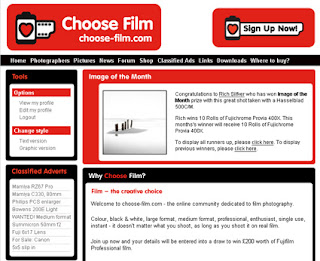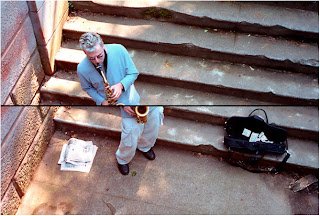Choose Film
Sites dedicated to film are not very common these days and it triggered me to sit down 'virtually' with Mr Jerry Deeney - a very friendly and accommodating representative from Fujifilm UK - to ask him some questions about the site - Choose Film.

Q: Good morning Mr Deeney. What is your position within FujiFilm UK?
A: "I'm the Marketing & Business Development Specialist for Professional Imaging, Fujifilm UK Ltd…which basically means I look after all of the marketing activity for the Fujifilm Professional film range in the UK. "
Q: It does not take long to realize that there are some very strong ties between the site Choose Film and Fujifilm. Who is behind the site - is it owned or sponsored by Fujifilm?
A: "We at Fujifilm UK created the site and Choose Film is fully owned by Fujifilm UK Ltd. "
Q: When did Choose Film open up:
A: "We launched Choose Film at the Focus-on-Imaging photo trade show in Birmingham, UK at the beginning of March 2007. "
Q: Why a site dedicated to film now? What triggered the idea of this site?
A: "We wanted to build a community for photographers that shoot on film. Everyday we speak to photographers who are tired of constantly being force fed that digital photography is better. Many of the magazines and photographic stores are spreading rumours that are frankly not true about the discontinuation of certain products and the demise of film photography. We wanted to quash these rumours and to build a home on the Internet where photographers could help to answer each others questions on film. Buy and sell film camera equipment, find film suppliers, second-hand film cameras and decent processing labs, show off their own work to the world and to generally have the knowledge that Fujifilm are still 100% behind film.
We are often asked why choose film is ‘non-Fuji’ branded. The reason is that we want Choose Film to stand on its own. We openly encourage members to upload any images shot on any brand brand of film. The site is a celebration of all things film. If we imposed ‘Fujifilm only’ rules, I think it would have spoiled the whole ethos of the idea."
Q: So it would be fair to say that Fujifilm continues to see a future for film in this increasingly digital world?
Q: "Absolutely! There will always be a market for film.
It has obviously become more of a niche market over the last few years. But, those that have gone digital for practical reasons – news, sport etc, went digital years ago. Film is a choice now, hence the name – ‘choose film’. It is a creative choice. People that choose film are choosing it for quality not for convenience."
Q: On that note, are there any planned, future releases of either new or updated emulsions from Fujifilm?
A: "Fujifilm Professional has released eight new emulsions in the past two years. The latest this year being the new Fujichrome Velvia 50 and the new Fujichrome Provia 400X films. The total number of films in our Professional and Consumer range is currently 27 different emulsions."
Q: What can you tell us about the future plans for Choose Film?
A: "We are never short of ideas for choose film. We are currently developing more functionality options for the members personal profile pages; we want to create a tighter network between the members, so that members can find other photographers with similar interests or that are local to each other.
We have a number of competitions and promotions planned for the year, which will be exclusive to the members of Choose Film"
Q: Are you yourself a film user and if so what is your choice of gear - and film?
A: "Yes, of course. I have been using film and film cameras for 20 years.
My current favourite is my Lomo LCA camera. For me, there is something about its unique polariser and vignette built into the lens that cannot be beaten. As for film, I don’t need to look any further than Fujifilm. For neg, I mainly use PRO400H, for Black & White – Neopan Acros 100 is an unsung hero, one of the finest black & white films on the market. For transparency it’s the new Velvia 50 for contrast and saturation or Astia 100F for subtlety and skin tones."
Q: Thanks again for the opportunity to find out more about the site and Fujifilm's plans for it. Any closing comments?
A: "We were quite overwhelmed by the response of Choose Film. We initially launched the site to the UK market, but quickly realised that the Internet knows no boundaries.
We found it very refreshing to hear from photographers all over world that they still love using film. No matter what Country, photographers are faced with the same problems – being forced by magazines to ‘go digital’ and finding a lack of support for film from the places it once thrived.
We hope that Choose Film can address some of these problems and can help its members to continue using film.
Choose Film is still only less than three months old, yet we have nearly 3,000 members signed up from all over the world. We feel there are many exciting things to come. Film technology is getting better everyday and our latest emulsions are best we have ever had.
For Choose-film.com and its members, this is just the beginning."
So, if you like me still enjoy the use of film - and appreciate seeing others working with that media - then take a moment and check out this new site and see what it has to offer.









